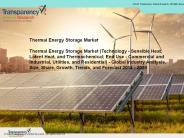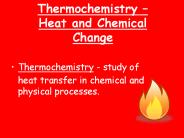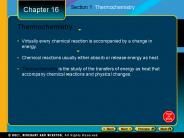Thermochem PowerPoint PPT Presentations
All Time
Recommended
If you feel warm after exercising, have you increased the ... Complete reaction between ammonium bromide and silver nitrate by writing a net ionic equation. ...
| PowerPoint PPT presentation | free to view
Thermodynamics Chapter 5 Thermochemistry Thermochemistry Thermodynamics study of energy and its transformation. Thermochemistry relationship of energy changes ...
| PowerPoint PPT presentation | free to download
Stoichiometry (12) (mol-mol, mole-mass, mass-mass, limiting reactant, % yield) ... Know the properties of acids and bases (taste, touch, litmus, pH, reactions) ...
| PowerPoint PPT presentation | free to view
Thermochemistry relationship of energy changes in chemical ... Heat Capacity of an obj (C) is the amt of heat necessary to raise tits tempt by 1 deg C ...
| PowerPoint PPT presentation | free to view
EIA projects total coal consumption will increase from 1.05 to 1.44 ... Passamaquoddy Tribe. Thomaston, ME. Industrial. Coal Tech Corporation. Williamsport, PA ...
| PowerPoint PPT presentation | free to view
The gasification market represents a critical nexus of energy production, environmental sustainability, and resource optimization. Gasification is a thermochemical process that converts organic or fossil fuels into syngas, a versatile energy source with applications ranging from electricity generation to chemical production. This analysis explores the key drivers, restraints, opportunities, market segments, required investments, and concludes with insights into the future of the gasification market.
| PowerPoint PPT presentation | free to download
Renewable naphtha market trends serve as driving forces in the global green energy transition. Increasing awareness of climate change, energy security, and resource scarcity propels the adoption of renewable naphtha as a viable alternative to conventional fuels. Policy incentives, corporate sustainability goals, and consumer preferences amplify market momentum, accelerating the shift towards renewable energy solutions. Embracing renewable naphtha trends enables stakeholders to capitalize on emerging opportunities, drive innovation, and contribute to a more resilient and sustainable energy ecosystem.
| PowerPoint PPT presentation | free to download
Application of Correlation-Gas Chromatography to Problems in Thermochemistry James S. Chickos Department of Chemistry and Biochemistry University of Missouri-St. Louis
| PowerPoint PPT presentation | free to download
Technology and procedures related to the creation, distribution, storage, and use of hydrogen as an energy source are collectively referred to as hydrogen technologies. Energy needs can be met while reducing environmental impact by utilizing hydrogen, the most plentiful element in the universe, in a variety of forms.
| PowerPoint PPT presentation | free to download
Hydrogen is a versatile and clean energy carrier that can be used in various applications. Here are some of the most commonly used hydrogen technologies & comparison of their advantages and disadvantages
| PowerPoint PPT presentation | free to download
Key Challenges for Hydrogen Technologies in The Future Hydrogen technologies have great potential, but before they can be successfully implemented and widely used in the future, a number of important issues must be resolved: Cost Competitiveness: Compared to traditional fossil fuel-based alternatives, the cost of producing hydrogen, especially green hydrogen from renewable sources, is now greater. Hydrogen production, storage, and infrastructure development come with significant capital and operating expenses, which makes it difficult for hydrogen technologies to become widely used. Infrastructure Development: A strong hydrogen infrastructure must be established before hydrogen technologies may be widely used. The construction of pipelines or other alternate distribution systems, refueling stations, storage facilities, and hydrogen generating facilities are all included in this.
| PowerPoint PPT presentation | free to download
According to the latest research report by IMARC Group, The global advanced phase change materials market size reached US$ 1.4 Billion in 2022. Looking forward, IMARC Group expects the market to reach US$ 2.9 Billion by 2028, exhibiting a growth rate (CAGR) of 12.74% during 2023-2028. More Info:- https://www.imarcgroup.com/advanced-phase-change-materials-market
| PowerPoint PPT presentation | free to download
There are several applications for hydrogen, an energy source that is flexible and clean. Hydrogen is the most common and lightest chemical element in the universe. Hydrogen, which is the building block of the cosmos, is also necessary for a variety of chemical reactions and processes.
| PowerPoint PPT presentation | free to download
According to the latest research report by IMARC Group, The global advanced phase change materials market size reached US$ 1.4 Billion in 2022. Looking forward, IMARC Group expects the market to reach US$ 2.9 Billion by 2028, exhibiting a growth rate (CAGR) of 12.74% during 2023-2028. More Info:- https://www.imarcgroup.com/advanced-phase-change-materials-market
| PowerPoint PPT presentation | free to download
Hydrogen is a clean, flexible energy source with a variety of applications. The most prevalent and lightest chemical element in the universe is hydrogen. The building block of the universe, hydrogen, is also required for a wide range of chemical reactions and processes. Read More - https://www.marketsandmarkets.com/industry-practice/hydrogen/hydrogen-technologies-comparison
| PowerPoint PPT presentation | free to download
An essential component in assessing the sustainability and practicality of hydrogen as a clean energy source is the analysis of the costs associated with producing hydrogen. To propel progress in this area, a thorough analysis of the cost of producing hydrogen must be carried out. We can find areas for cost improvement by looking at several manufacturing techniques, like steam methane reforming or electrolysis, and evaluating the costs associated with each stage.
| PowerPoint PPT presentation | free to download
Hydrogen is a clean, adaptable energy source that has a wide range of uses. The most prevalent and lightest chemical element in the universe is hydrogen.
| PowerPoint PPT presentation | free to download
Hydrogen is a clean, adaptable energy source that has a wide range of uses. Read More - https://www.marketsandmarkets.com/industry-practice/hydrogen/hydrogen-technologies-comparison
| PowerPoint PPT presentation | free to download
Analysis of Biomass and Biofuels as source of energy Guests on today s show K. Vaideesh Subbaraj Shivendra Upadhyay M. Vishwanath With your favorite host
| PowerPoint PPT presentation | free to view
313 101 Chemistry I (Thermochemistry) . . 4511-1
| PowerPoint PPT presentation | free to view
Download Free Research Report PDF @ http://bit.ly/34Oa7hA #BioBasedEthylene #MarketAnalysis Bio-Based Ethylene ( Bio-ethylene) is produced from bio-based material. Traditional ethylene, on the other hand, is manufactured from fossil fuels through thermochemical processes. Similar to traditional ethylene, bio-ethylene can be used as a raw material for a variety of organic chemicals and plastics. Bio-Based Ethylene is generally produced from bioethanol. Fermentation of pre-treated biomass results in the production of bioethanol. Bioethanol is primarily used as a blend in transportation fuel.
| PowerPoint PPT presentation | free to download
Download Free Research Report PDF = http://bit.ly/2N97Gjx #Bio-ethylene(bio-based ethylene)#MarketAnalysis Bio-ethylene (bio-based ethylene) is produced from bio-based material. Traditional ethylene, on the other hand, is manufactured from fossil fuels through thermochemical processes. Similar to traditional ethylene, bio-ethylene can be used as a raw material for a variety of organic chemicals and plastics. Bio-ethylene is generally produced from bioethanol. Full Report Url@ http://bit.ly/2TB3MRW
| PowerPoint PPT presentation | free to download
Download Free Research Report PDF : http://bit.ly/2ZrYMkE Nitriding furnaces are used in the process of nitriding metals using ammonia. Gas nitriding is a thermochemical treatment, which hardens the product.
| PowerPoint PPT presentation | free to download
Thermodynamics Honors Unit 5
| PowerPoint PPT presentation | free to download
Title: Author: 2d-flow Last modified by: William Created Date: 2/25/2002 11:42:08 AM Document presentation format: (4:3)
| PowerPoint PPT presentation | free to view
Chapter 7: Energy and Chemical Change Chemistry: The Molecular Nature of Matter, 6E Jespersen/Brady/Hyslop 1. Determine how much heat is absorbed by the calorimeter.
| PowerPoint PPT presentation | free to download
Thermal Energy Storage Market (Technology - Sensible Heat, Latent Heat, and Thermochemical; End Use - Commercial and Industrial, Utilities, and Residential) - Global Industry Analysis, Size, Share, Growth, Trends, and Forecast 2014 - 2020
| PowerPoint PPT presentation | free to download
Title: Ch 8: Chemical and physical change; energy, rate and equilibrium Author: default user Last modified by: Upali Siriwardane Created Date: 11/7/2002 2:27:54 PM
| PowerPoint PPT presentation | free to view
Sixth Edition. Chapter 8 Thermochemistry
| PowerPoint PPT presentation | free to view
Waste to Energy Market (Waste Type - Municipal Solid Waste (MSW), Agricultural Waste; Technology - Thermochemical (Incineration, Others), Biochemical (Anaerobic Digestion, Others); Application - Electricity, Heat) - Global Industry Analysis, Size, Share, Growth, Trends, and Forecast 2018 - 2026
| PowerPoint PPT presentation | free to download
Slide 1 ... Thermochemistry
| PowerPoint PPT presentation | free to view
Chapter 12 Cookies? When baking cookies, a recipe is usually used, telling the exact amount of each ingredient If you need more, you can double or triple the amount ...
| PowerPoint PPT presentation | free to view
... is energy that transfers from one object ... concerned with heat changes that occur during chemical reactions Energy - capacity for doing work or supplying heat ...
| PowerPoint PPT presentation | free to download
Waste to Energy Market (Waste Type - Municipal Solid Waste (MSW), Agricultural Waste; Technology - Thermochemical (Incineration, Others), Biochemical (Anaerobic Digestion, Others); Application - Electricity, Heat) - Global Industry Analysis, Size, Share, Growth, Trends, and Forecast 2018 - 2026
| PowerPoint PPT presentation | free to download
Thermochemistry Heat and Chemical Change Thermochemistry - study of heat transfer in chemical and physical processes.
| PowerPoint PPT presentation | free to view
Title: I. Stoichiometric Calculations Author: Robert E. Johannesson Last modified by: CUSD95 Created Date: 2/27/2000 8:14:20 PM Document presentation format
| PowerPoint PPT presentation | free to download
Chapter 16 - Energy and Chemical Change Energy and Heat Thermochemistry - concerned with heat changes that occur during chemical reactions Energy - capacity for doing ...
| PowerPoint PPT presentation | free to view
Chapter 17 Thermochemistry Pre-AP Chemistry Charles Page High School Stephen L. Cotton Section 17.1 The Flow of Energy Heat and Work OBJECTIVES: Explain how ...
| PowerPoint PPT presentation | free to download
Extra Slides ... Extra Slides
| PowerPoint PPT presentation | free to download
... to evolved N2 Sulfide oxidized to dissolved sulfate High-Temperature Calorimetry 700oC 25oC 700oC 25oC 700oC 25oC DS TTD SOL Thermochemical Cycles ...
| PowerPoint PPT presentation | free to download
The Nature of Energy Energy is the ability to do work or produce heat. weightless, odorless, tasteless Two forms of energy exist, potential and kinetic.
| PowerPoint PPT presentation | free to view
Bomb Calorimetry constant volume often used for combustion reactions heat released by reaction is absorbed by calorimeter contents need heat capacity of calorimeter
| PowerPoint PPT presentation | free to download
Section 1 Thermochemistry Chapter 16 Thermochemistry Virtually every chemical reaction is accompanied by a change in energy. Chemical reactions usually either absorb ...
| PowerPoint PPT presentation | free to view
Nuclear Power Need and Future * Nuclear energy has the lowest production costs of any widely expandable fuel for electricity generation even coal.
| PowerPoint PPT presentation | free to download
Thermochemistry Definitions Energy capacity for doing work or supplying heat. Thermochemistry study of energy changes that occur during phase changes and chem ...
| PowerPoint PPT presentation | free to download
Title: THERMOCHEMISTRY or Thermodynamics Author: J. Kotz Last modified by: hisham Created Date: 3/5/1999 5:23:29 PM Document presentation format: A4 Paper (210x297 mm)
| PowerPoint PPT presentation | free to view
Energy Changes in Chemical Reactions *
| PowerPoint PPT presentation | free to view
Fallacies of a Hydrogen Economy
| PowerPoint PPT presentation | free to view
Enthalpy Changes Phase changes involve changes in the potential energy of a system. Chemists use the term enthalpy change ( H) to refer to the potential energy ...
| PowerPoint PPT presentation | free to view
Hess s Law If you add two or more thermochemical equations to give a final equation, then you can also add the heats of reaction to give the final heat of reaction.
| PowerPoint PPT presentation | free to download
Thermochemistry The study of energy during physical changes and chemical changes.
| PowerPoint PPT presentation | free to view
MANTLE PLUMES, plumes and plumes: do we need all of them
| PowerPoint PPT presentation | free to download
Title: Presentation Title Arial 36 Presentation Arial 36 Author: Catherine Meek Last modified by: Ted B. Wertheimer Created Date: 2/24/2002 8:22:53 PM
| PowerPoint PPT presentation | free to download
The Reaction module Reaction calculates the thermochemical properties of a species, a mixture of species or a chemical reaction. Reaction accesses only compound ...
| PowerPoint PPT presentation | free to download
We use the following equations to solve calorimetry problems: q = n . c. p ... If a 12 fl. oz. can of Coke contains 140 Cal and a 16 oz. Starbucks Grande latte with 2 ...
| PowerPoint PPT presentation | free to view
























































